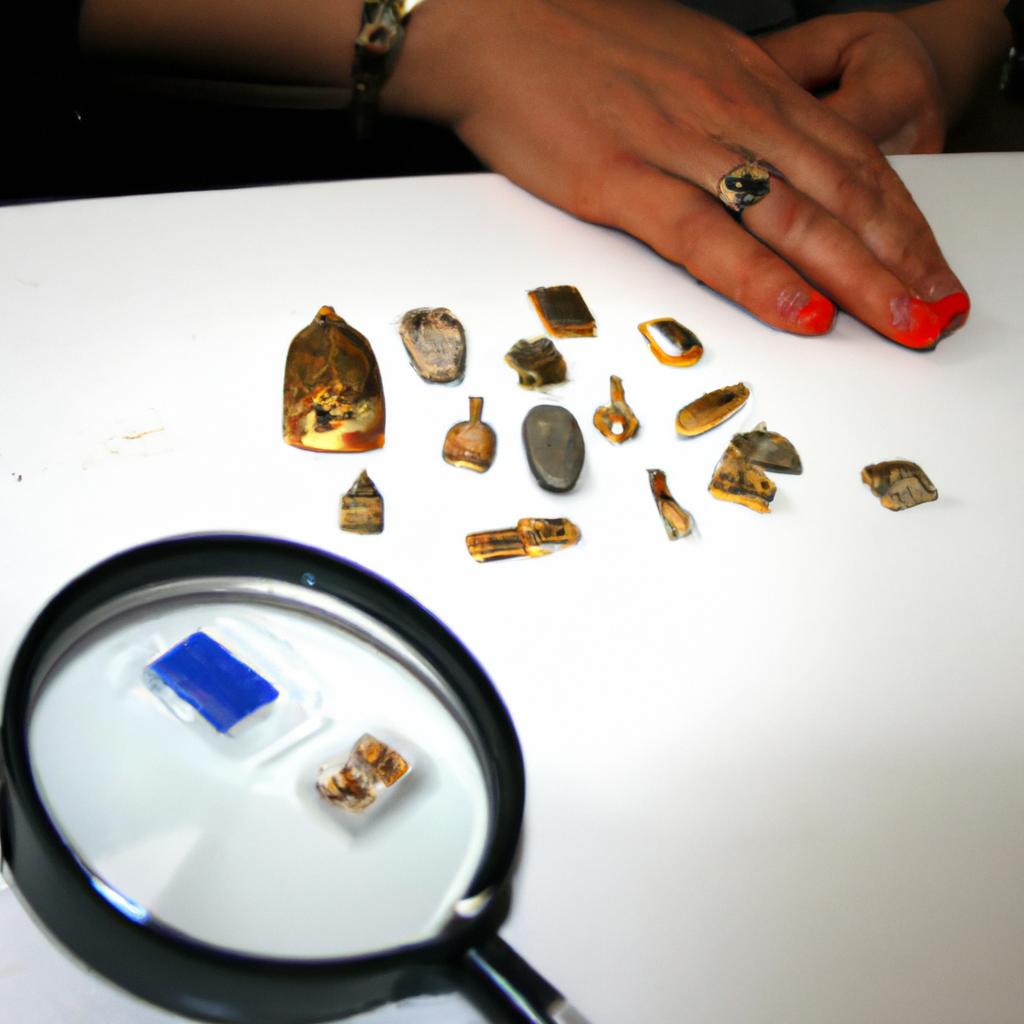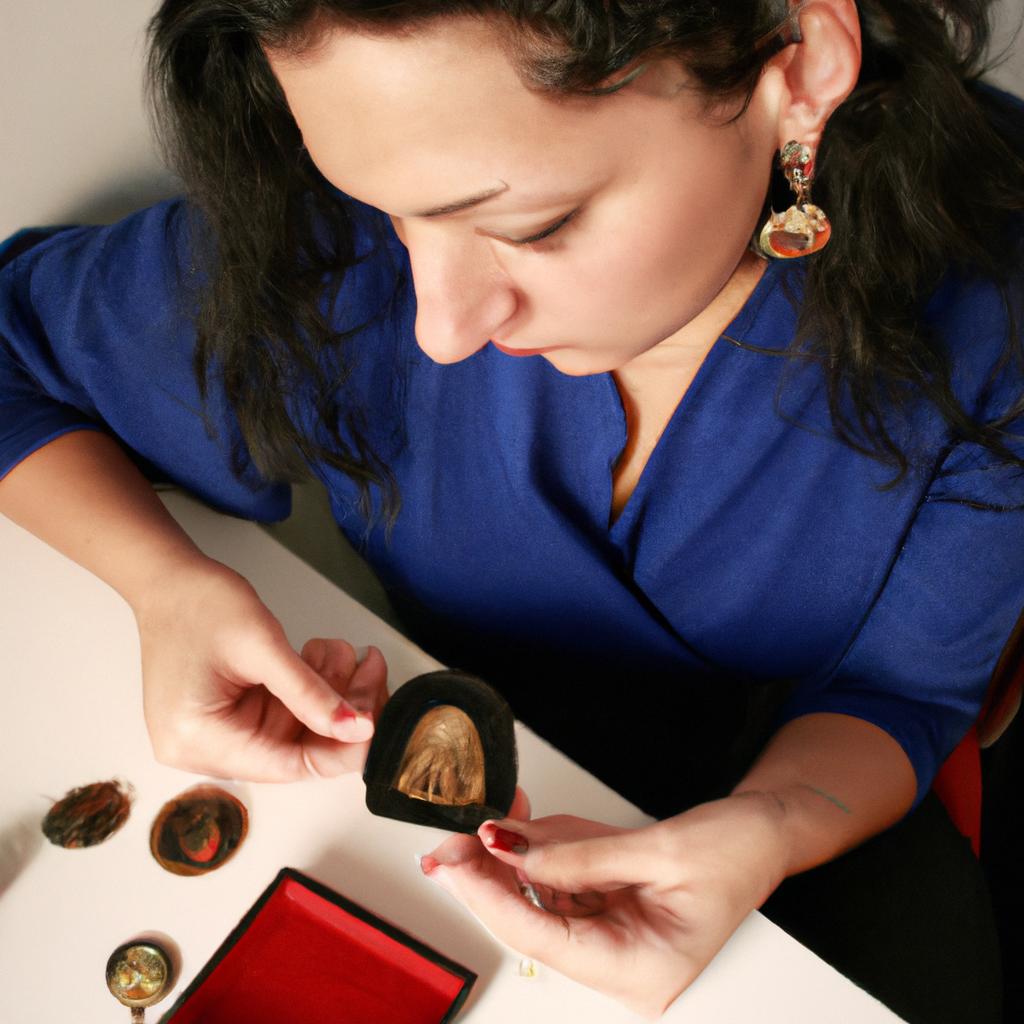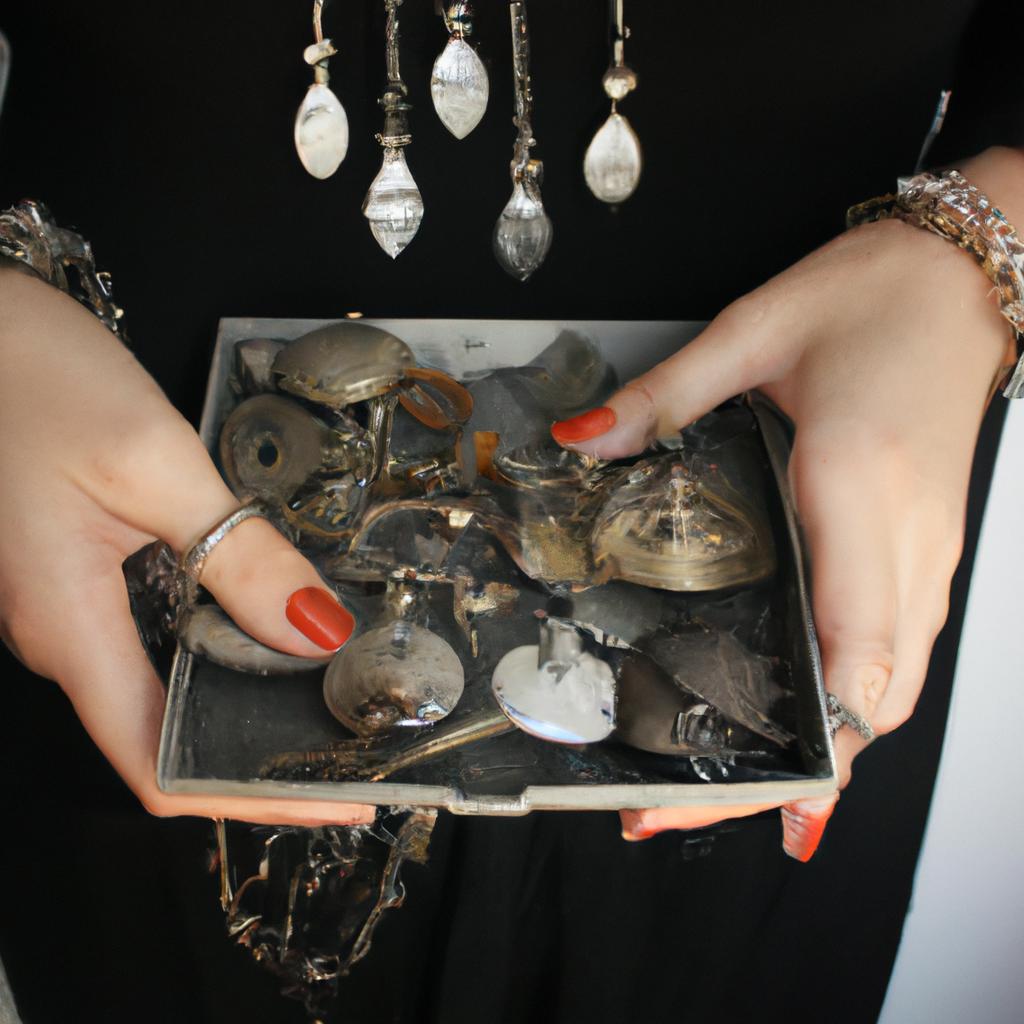Symbols have played a significant role in human society throughout history, and jewelry has long served as a medium for expressing these symbolic meanings. From ancient civilizations to modern times, various cultures across the globe have utilized symbols in their jewelry designs to communicate messages, beliefs, and identities. This article delves into the rich history of symbols in jewelry, exploring their significance and meaning.
One compelling example that highlights the importance of symbols in jewelry is the use of ankh symbol by the ancient Egyptians. The ankh was a key-shaped symbol often depicted with a loop at the top. It represented eternal life and was believed to hold great power and protection. Egyptians would fashion this symbol into amulets or incorporate it into intricate necklace pendants to carry its divine essence close to their hearts. By wearing such jewelry adorned with the ankh, individuals sought not only personal protection but also wished to align themselves with higher spiritual forces associated with everlasting life.
Throughout different periods and regions, symbolism continued to evolve in jewelry craftsmanship. These symbols ranged from religious icons representing faith or deities’ attributes to cultural emblems signifying social status or group affiliations. Understanding the historical context behind these symbols provides valuable insights into how humans have used adornments as powerful tools for self-expression and communication throughout history.
For instance, during the Renaissance period in Europe, jewelry often featured symbols associated with Christian beliefs. Crosses, crucifixes, and images of saints were commonly incorporated into necklaces, rings, and pendants as a way for individuals to display their devotion or seek divine protection. These pieces not only served as personal adornments but also allowed wearers to publicly identify themselves as members of the Christian faith.
In addition to religious symbolism, jewelry has also been used to express cultural identities and social affiliations. In ancient Celtic cultures, intricate knotwork designs symbolized interconnectedness and continuity. These patterns were often seen in brooches, bracelets, and torcs worn by Celts to denote their heritage and allegiance to their clans or tribes.
Similarly, Native American tribes utilized symbols in their jewelry to convey their tribal affiliations and spiritual beliefs. The use of animal motifs such as bears, eagles, or wolves represented specific qualities or characteristics associated with these creatures. By wearing jewelry adorned with these symbols, Native Americans expressed their connection to nature and the importance of maintaining harmony with the natural world.
Fast-forwarding to modern times, symbols continue to hold significance in contemporary jewelry design. From the iconic heart shape symbolizing love and affection to the peace sign representing unity and pacifism, these symbols resonate with people on both personal and universal levels.
Moreover, individual preferences for certain symbols can vary widely based on personal experiences, cultural backgrounds, or even current trends. Some may choose jewelry embedded with birthstones or zodiac signs as a way of celebrating their unique identity or connecting with cosmic energies.
Ultimately, symbols in jewelry serve as visual languages that transcend barriers of time and culture. They allow individuals to communicate their values, beliefs, and identities without uttering a single word. Whether it be through ancient amulets carrying spiritual power or contemporary charm bracelets reflecting personal milestones – the language of symbolism continues to captivate and inspire us through the art of jewelry.
Ancient Symbolic Jewelry: Unveiling the Origins
In ancient civilizations, jewelry held immense symbolic value, representing cultural beliefs, social status, and personal identity. One fascinating example of this can be seen in the use of scarab amulets by the ancient Egyptians. These small beetle-shaped pendants were believed to have protective powers and were often inscribed with hieroglyphs or symbols associated with deities such as Ra or Osiris.
To understand the significance and meaning behind ancient symbolic jewelry, it is essential to explore its origins. The first civilization to widely adopt the practice of adorning oneself with jewelry was Ancient Mesopotamia, where precious gemstones like lapis lazuli and carnelian adorned necklaces and bracelets. They also used semiprecious stones like jasper and obsidian for ceremonial purposes.
The symbolism expressed through these ancient treasures evokes a sense of wonder and curiosity about our ancestors’ lives. It reminds us that even thousands of years ago, people sought meaning beyond the material world. Here are some key aspects worth pondering:
- Connection to Nature: Many ancient cultures incorporated natural elements into their jewelry designs, reflecting their deep connection to the environment. For instance, Celtic jewelers crafted intricate pieces inspired by flora and fauna found in their surroundings.
- Protection and Power: Talismanic symbols engraved on amulets or charms served as protection against evil forces or brought good fortune to the wearer’s life.
- Rituals and Ceremonies: Certain jewelry items had specific roles within rituals or ceremonies. Ancestor worship practices involved wearing memorial pieces honoring deceased family members.
- Social Hierarchy: In societies where class distinctions were prominent, jewelry played a role in showcasing one’s wealth and position in society.
Table 1 provides an overview of different types of ancient symbolisms found across various cultures:
| Cultures | Symbolism | Examples |
|---|---|---|
| Ancient Egypt | Protection | Scarab amulets |
| Ancient Greece | Divinity | Olive wreaths |
| Vikings | Valor and Strength | Thor’s hammer pendants |
| Mayans | Spirituality | Jade masks |
The origins of ancient symbolic jewelry are rooted in the human desire to express beliefs, capture meaning, and connect with something larger than oneself. This exploration sets the stage for further examination of religious symbolism—the power of faith embedded within intricate pieces of jewelry—discussed in the subsequent section.
Religious Symbolism: The Power of Faith in Jewelry
In our exploration of ancient symbolic jewelry, we have delved into the fascinating origins and rich history behind these enigmatic adornments. Now, let us turn our attention to another profound aspect of jewelry symbolism – religious symbolism.
To better understand the power of faith in jewelry, let us consider an example. Imagine a pendant adorned with a delicate cross, worn by a devout Christian believer. This piece of jewelry serves as a constant reminder of their unwavering devotion and connection to their faith. Here, the symbol itself holds immense significance, representing sacrifice, redemption, and hope.
Religious symbolism in jewelry transcends cultures and has been present throughout human history. The following bullet point list highlights some common symbols found in religious jewelry:
- The Star of David represents divine protection and unity within Judaism.
- The Om symbolizes spiritual oneness within Hinduism and Buddhism.
- The Ankh signifies eternal life in Ancient Egyptian beliefs.
- The Crescent Moon is associated with Islam and symbolizes growth and renewal.
Now, let us take a moment to explore these symbols further through a table that showcases their meanings across different religions:
| Symbol | Religion | Meaning |
|---|---|---|
| Star of David | Judaism | Divine protection and unity |
| Om | Hinduism/Buddhism | Spiritual oneness |
| Ankh | Ancient Egypt | Eternal life |
| Crescent Moon | Islam | Growth and renewal |
As we can see from this representation, religious symbolism in jewelry provides individuals with not only personal meaning but also connects them to larger communities united by shared beliefs. These sacred symbols serve as visual expressions of one’s spirituality, grounding believers in their faith.
With our exploration into religious symbolism complete, we now transition into the next section where we will delve into cultural symbolism within jewelry. By examining the diverse representations and meanings of jewelry across various cultures, we gain a deeper appreciation for the immense diversity that exists within this art form.
Cultural Symbolism: Exploring Diversity in Jewelry
Section Title: Cultural Symbolism: Exploring Diversity in Jewelry
Building upon our exploration of religious symbolism, we now turn our attention to cultural symbolism found within jewelry. Across different societies and civilizations, the use of symbols in adornments has served as a means of expressing identity, beliefs, and values. Through various examples, let us delve into the rich tapestry of cultural symbolism embedded in jewelry.
Example:
Consider an intricately designed necklace adorned with miniature replicas of traditional African masks. This captivating piece not only showcases exquisite craftsmanship but also represents the deep-rooted connection between art and culture. The wearer proudly exhibits their African heritage through this symbolic expression, inviting curiosity and appreciation from others.
Cultural Symbolism in Jewelry:
To further understand the significance of cultural symbolism in jewelry, let us explore some common themes that emerge across different cultures:
- Ancestral Homage: Many cultures utilize symbols to pay homage to ancestors or honor familial bonds. These symbols can be passed down through generations as heirlooms or crafted specifically for ceremonial occasions.
- Protection and Good Luck: Certain jewelry pieces incorporate protective symbols believed to ward off evil spirits or bring good fortune. These talismanic objects serve both practical purposes and carry deeply ingrained cultural beliefs.
- Social Status and Wealth: In societies where social hierarchy plays a significant role, jewelry often serves as a symbol of prestige and wealth. Elaborate designs featuring precious gemstones or intricate metalwork are indicative of one’s elevated status.
- Regional Identity: Geographically diverse regions have distinct cultural identities reflected in their jewelry. From tribal motifs representing unity among indigenous communities to regional flora and fauna depicted in ornamental forms, these symbols celebrate local traditions.
Table showcasing cultural symbols in jewelry:
| Culture | Symbol | Meaning |
|---|---|---|
| Egyptian | Ankh | Eternal life |
| Celtic | Triquetra | Unity of mind, body, and spirit |
| Indian | Om | Universal sound |
| Native American | Dreamcatcher | Protection from bad dreams |
As we have explored the realm of cultural symbolism in jewelry, it becomes evident that these adornments serve as powerful conduits for expressing identity and heritage. Now, let us delve into another captivating aspect—the hidden meanings behind symbolic gemstones.
[Subsequent Section: Symbolic Gemstones: Unlocking the Hidden Meanings]Symbolic Gemstones: Unlocking the Hidden Meanings
Continuing our exploration of cultural symbolism within jewelry, let us delve into the diverse range of symbols that have been incorporated into various designs throughout history. By examining one particular example, we can gain a deeper understanding of how these symbols hold significance and meaning for different cultures.
Consider the ancient Egyptian culture, where scarab beetles held great importance as symbols of rebirth and regeneration. In their intricate jewelry pieces, Egyptians often included scarab beetle motifs to represent eternal life and protection. This symbol not only adorned their personal adornments but also found its place in amulets and talismans worn by both royalty and commoners alike.
To further explore the rich tapestry of cultural symbolism in jewelry, here are some key aspects worth considering:
- Universal Symbols: Certain symbols transcend specific cultures and possess universal meanings. For instance, the infinity symbol represents eternity in many societies, while the lotus flower signifies purity across multiple civilizations.
- Regional Variations: Different regions may interpret similar symbols in unique ways. The tree of life motif is present across numerous cultures worldwide; however, each interpretation showcases distinct regional influences and beliefs.
- Historical Context: Understanding the historical context surrounding a symbol’s usage is crucial to comprehending its true significance. For example, during times of political turmoil or social change, certain symbols might acquire new connotations or be repurposed to convey messages of resistance or unity.
- Contemporary Adaptation: Symbols continue to evolve with changing societal norms and fashion trends. Today’s designers often reinterpret traditional symbols to create contemporary pieces that honor heritage while appealing to modern sensibilities.
Symbolic diversity within jewelry reflects the multitude of human experiences across time and geography. As we move forward on this journey through symbolic expressions in adornment, let us now turn our attention towards another facet – exploring gemstones and their hidden meanings.
Mystical Symbols: The Enigmatic World of Esoteric Jewelry awaits our exploration, where we will unravel the secrets behind symbols that have fascinated and intrigued humanity for centuries.
Mystical Symbols: The Enigmatic World of Esoteric Jewelry
Symbols have played a significant role in the history of jewelry, and their meanings can be traced back through centuries. Building on the exploration of symbolic gemstones in the previous section, this section delves into the enigmatic world of esoteric jewelry, which encompasses mystical symbols that hold deep cultural and spiritual significance.
To illustrate the power and allure of esoteric jewelry, let us consider the case of a hypothetical antique pendant adorned with a pentagram symbol. The pentagram has been associated with various meanings throughout history, including protection, balance, and spirituality. This particular pendant dates back to the 18th century and belonged to a renowned alchemist who used it as an amulet during his experiments. Its intricate design features five interlocking triangles representing earth, air, fire, water, and spirit – elements believed to govern existence according to ancient mysticism.
The use of mystical symbols in esoteric jewelry serves multiple purposes:
- Spiritual Connection: Symbols such as mandalas or yantras are used as tools for meditation and spiritual connection. They provide a visual representation of complex concepts or divine energies that aid practitioners in focusing their thoughts and intentions.
- Personal Empowerment: Wearing talismans engraved with symbols like the Eye of Horus or the Celtic triskele is believed to bring luck, protection from negative forces, and empowerment to individuals seeking strength or guidance.
- Cultural Identity: Certain symbols carry strong cultural connotations; wearing them allows individuals to express pride in their heritage or affiliation with specific belief systems.
- Aesthetic Appeal: Beyond their symbolic meaning, many designs featuring these esoteric symbols are visually captivating. Their intricate patterns and delicate craftsmanship make them highly sought-after pieces of art.
Table: Examples of Esoteric Symbols in Jewelry
| Symbol | Meaning | Cultural Association |
|---|---|---|
| Om | Universal sound symbolizing cosmic energy | Hinduism, Buddhism |
| Ankh | Symbol of life and immortality | Ancient Egyptian |
| Hamsa | Hand-shaped symbol protecting against evil eye | Middle Eastern cultures |
| Tree of Life | Represents interconnectedness of all creation | Various traditions |
The allure of esoteric jewelry lies in its ability to evoke a sense of mystery, spirituality, and personal connection. Each symbol carries with it layers of history and cultural significance that resonate deeply within individuals who wear them.
Transitioning into the subsequent section on modern symbolism: Contemporary Expressions in Jewelry, we see how these age-old symbols continue to inspire contemporary designers as they reinterpret their meanings for a new era.
Modern Symbolism: Contemporary Expressions in Jewelry
Transitioning from the mystical symbols of esoteric jewelry, we now turn our attention to modern symbolism and its expression through contemporary jewelry designs. In today’s world, jewelry not only serves as a fashion statement but also allows individuals to convey their personal beliefs, values, and messages. The use of symbolic elements in modern jewelry has become increasingly popular, reflecting the ever-evolving nature of human expression.
To illustrate this point, let us consider an example: a pendant adorned with a small tree charm. This piece of jewelry symbolizes growth, strength, and connection to nature. By wearing such a necklace, one can express their affinity for environmental causes or signify personal growth and resilience. This example highlights how modern symbolism is intertwined with individuality and self-expression.
The significance of symbols in contemporary jewelry can be seen through several key aspects:
- Personalization: Modern jewelers often offer customizable pieces where customers can choose specific symbols that hold deep meaning for them. This allows individuals to create unique jewelry that tells their own story.
- Cultural Influences: Symbols drawn from various cultures are frequently incorporated into contemporary designs. These cultural motifs serve as a means of connecting people across borders while celebrating diversity and heritage.
- Social Activism: Many jewelers utilize symbolic representations to raise awareness about social issues or advocate for change. For instance, a bracelet featuring the symbol of a raised fist may support movements fighting against inequality and injustice.
- Emotional Connection: Through the use of meaningful symbols, jewelry becomes more than just an accessory; it becomes a tangible reminder of important memories, emotions, or aspirations.
| Symbol | Meaning | Emotion |
|---|---|---|
| Lotus flower | Rebirth | Hope |
| Dove | Peace | Serenity |
| Infinity symbol | Eternal love | Endearment |
| Compass | Guidance | Adventure |
Incorporating symbols into contemporary jewelry allows individuals to express their identity, values, and aspirations in a unique and personal manner. Whether it is through cultural motifs or socially conscious designs, modern symbolism creates an emotional connection between the wearer and the piece itself. By embracing this expressive form of adornment, one can communicate deeper messages without uttering a single word.
 Shanes Jewelry
Shanes Jewelry



